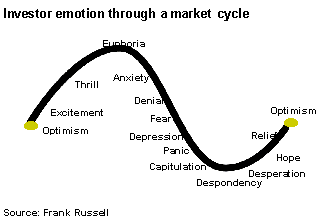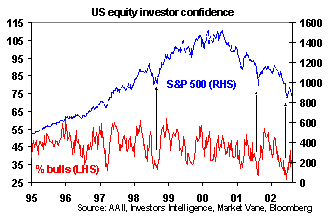Its all in the mind – investor psychology
Until the 1980s the dominant economic theory was that financial markets were efficient. Dr Shane Oliver reports on investor psychology.
Monday, October 14th 2002, 12:19PM
Until the 1980s the dominant economic theory was that financial markets were efficient – in other words, that all relevant information was reflected in asset prices and this was done so in a rational manner. Faith in the Efficient Markets Hypothesis (EMH) started to unravel through the 1980s. However, the October 1987 crash was possibly the nail in the coffin of the EMH as it was virtually impossible to explain why US shares fell over 30 per cent in a two month period when there was scant new information to justify such a move.
The same can currently be asked of the Nasdaq – what has changed since March 10, 2000 when the tech-heavy Nasdaq index peaked at 5132? The Nasdaq is now trading below 1200. To be sure, there has been the US/global economic downturn and a collapse in demand for information and communication technology – but surely these things are relatively normal and should have been allowed for?
Enter behavioural finance
With the waning of faith in the concept that markets are always efficient, the role of investor confidence and psychology has come to be more widely recognised. In fact, the concept opened up a whole new discipline called behavioural finance.
In explaining the bull and bear phases evident in asset markets (including residential real estate), it’s not as simple as saying that when investors are confident asset prices rise and when investors are not confident, they fall. Rather, several aspects of behavioural finance appear to interact, of which two aspects are key.
1. Individuals are less than perfectly rational
First, people experience lapses in logic when processing information and forming judgements. Some of these arise from trying to deal with complex problems, and information overload. Others are harder to rationalise. Numerous studies by psychologists have identified that people:
- tend to down play uncertainty and project the current state of the world into the future (resulting in a tendency, for example, to assume that recent share price gains will continue);
- over-emphasise recent, spectacular or personal experiences in assessing the probability of events occurring. This results in an emotional involvement with an investment strategy – if the strategy has been winning recently an investor is more likely to expect it will continue. Once a bubble gets underway investors’ emotional commitment continues to steadily rise, thus perpetuating it;
- tend to be overconfident in their own abilities;
- tend to be overly conservative in adjusting their expectations to new information and do so slowly over time (explaining why bubbles and crashes normally unfold over long periods);
- tend to ignore information that conflicts with past decisions (again helping to perpetuate a bubble once it gets underway); and
- require less information to predict a desirable event than an undesirable one (“wishful thinking”) - which may partly explain why asset price bubbles normally precede crashes rather than the opposite.
Secondly, “crowd psychology” tends to magnify and reinforce individual judgements. Investment markets have long been thought of as providing examples of crowd psychology. Collective behaviour requires the presence of several key aspects, including:
- a means by which behaviour can be contagious (eg, mass communication);
- a structural strain to exist – such as the threat of losing (or missing out on) financial wealth;
- a general belief that grows and spreads (eg, that share prices only go up): and
- a precipitating event takes place to give the general belief some substance (eg, strong economic growth or a technological breakthrough).
In relation to investment markets, the communication mechanisms for collective market views include:
- the general media - where stories of sharp rises/falls in asset prices, etc, grab investor attention and provide a positive feedback loop to prevailing trends, and
- pressure for conformity via such diverse mechanisms as industry standards, interaction with friends, monthly performance charts and benchmarking (which discourage big “risk” taking and deviation from the crowd). Examples of collective thinking which helped drive the US share price surge of the late 1990s included the consensus that indexing was the single way to go and the view that you can’t lose if you “buy the dips”.
The combination of lapses in logic by individuals when processing information and forming expectations, and the reinforcing effect played by crowd psychology, go a long way to explaining why speculative surges in asset prices develop (usually after some favourable fundamental development), and how they feed on themselves (as individuals project recent price gains into the future, exercise “wishful thinking” and receive positive feedback via the media, etc).
Of course the whole process goes into reverse once buying is exhausted, often triggered by contrary news to that which drove the rise initially.
Investor psychology through the cycle
Specifically, investor psychology appears to develop through a market cycle in a fashion something like this:

To relate this to recent experience in equity markets, investor sentiment was generally euphoric in late 1999 and early 2000 when the US share market surged to its March 2000 peak levels. At the time, broad media messages were extremely positive and bestselling books were promising Dow 36,000.
As the market collapsed positive sentiment gave way to fear and depression about a year ago but in recent times we have probably sunk into capitulation and despondency. A degree of capitulation is certainly evidenced by recent record outflows from US equity mutual funds.
By contrast, the residential property market is now approaching the opposite point in the cycle. House prices have risen, and along with low interest rates, sentiment has been partly driven by homeowner fears that this will continue. The conventional wisdom is that “you are safe in bricks and mortar”, and people become scared of missing out. Reports of surging house prices have helped reinforce the positive attitude towards housing as an investment.
There are several points to note
Firstly, confidence and investor psychology do not act in a vacuum. The move from despondency at the bottom of a cycle to euphoria at the top is usually initially driven by favourable fundamental developments, eg strong economic growth and easy monetary conditions.
Secondly, at market extremes confidence is best read in a contrarian fashion – major bull markets do not start when investors are feeling euphoric and major bear markets do not start when they are feeling depressed. The reason is that by the time investor confidence has reached these extremes all those who wish to buy/sell have done so, meaning that it only requires a small amount of bad/good news to tip investors back the other way. From the chart below it can be seen that extreme low points in investor confidence are often associated with market bottoms, eg, in 1998 and September 2001. For this reason many strategists monitor investor sentiment as a guide to when market extremes may have been reached. Currently US investor sentiment is heading back down to the bearish extremes of July.

Conclusions
- Investor psychology, driven by the combination of the lapses in logic that people experience in making decisions, and crowd psychology, goes a long way to explaining why asset prices go through periodic booms and busts.
- The key point is to be aware of the role of investor psychology. In particular it usually pays to be contrarian. Extremes of bullishness often signals market tops, whereas extremes of bearishness often signals market bottoms.
- Unfortunately, contrarian investing isn’t always easy. As John Maynard Keynes once remarked, “The market can often stay irrational longer than you can stay solvent”.
This Investment Insights is written by Dr. Shane Oliver, Chief Economist and Head of Investment Strategy for AMP Henderson Global Investors in Sydney.
Special Offers
« Market Review: Bonds set for a fall? King builds an empire » Commenting is closed
Printable version
Email to a friend









